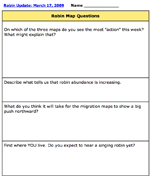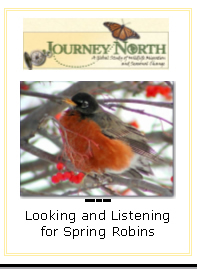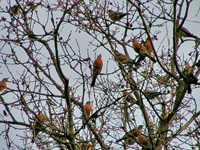Your Sightings! >>
Today's Report Includes:
- The Migration: Maps, Questions, Highlights
- Citizen Scientists Report: What Are They Observing?
- Journal Question: Locals or Migrants?
- Identify Northern Outposts: When Will Robins Reach the End of the Trail?
- Scientists Investigate: Any Worms for Rocky Mountain Early Robins?
- Digging Deeper: Go on a Worm Hunt
- Links: This Week's Robin Resources to Explore

Photo
Andy Wilson
What
are these robins doing, and why? Click
for More >>
| Highlights:
Abundance
Increasing |
Today's Map Questions >> |
Many of you observe what robins are doing but you wonder why. You wonder where they're coming from and where they are going. A robin's behavior can help you know the answers. Get ready for this week's journal topic by reading the details from a few recent sightings:
- Explore recent sightings! >>
Expand Your Migration Journal
Collect and reflect on observations
and learning experiences while you wait and watch for your robins
to return.
We now have two new page choices (with links to teacher guides)
for your robin journals
|
For
Your Journal |
This observer gives us this week's journal question:
"At first they looked a lot like kids playing on a jungle gym in those trees. Ten or more would be hopping from branch to branch, tree to tree, running on the ground, eating berries, socializing, and chasing each other. They were very hyper. No territories seemed to be established yet. One thing I'm not sure about: Are these robins migrants, or locals hunkering in the valley — or both?"
- Are these locals or migrants — or both? Explain your answer.
Robin migration is tightly connected to weather. One theory says that robins migrate along with average temperatures of 36 degrees F. Investigate this theory and it can help you make predictions about when the robins will reach the NOPs and the end of the trail! Dig in here:
- Lesson: When Will Robins Reach the End of the Trail? >
Take the challenge! Start watching the temperature maps and filling in your NOP prediction log today. (We'll be adding the actual NOP arrivals and singers as their sighting dates are reported.)
Teacher Guide >>
Robins migrate northward in the spring — and some robins migrate “upward” too! It takes a while for spring to climb a mountain. A group of scientists working in a Colorado mountain lab wondered about robins that came there to breed. They knew that 20 years earlier, the birds arrived around April 4th. But now the robins are showing up earlier. What could be the advantages of robins arriving on breeding grounds earlier than usual? What could be the disadvantages? Find out here:
- Rocky Mountain Robins: The Early Bird Has No Worms! >>
Mrs. Kistler's third grade class reported seeing worms out after a warm rain. (March 9, Cub Run, KY) Have YOU noticed any earthworms yet? Robins and worms have an important connection.
Please start looking for earthworms, and keep sending your sightings of robins: The first robin you SEE, WAVES of robins, the first robin you HEAR singing its territorial song. Your data help build the real-time story of spring migration 2009. Thank you, citizen scientists!

A Humorous Read-Aloud >>
- Look Closely (Photo Study): What are these robins doing, and why? >>
- Predict (Lesson): Testing a Temperature Theory About Robin Migration >>
- Predict and Record: When Will Robins Reach the End of the Trail? >>
- Observe: Local or Migrant: Which is Which? >>
- Observe (Checklist): Spring Phenology of Robins >>
- Slide Show: Rocky Mountain Robins: The Early Bird Has No worms >>
- Observe and Collect: Worm Hunt! >>
- Ask
the Expert: Send Questions By Noon, March 20 >>
The Next American Robin Migration Update Will Be Posted on March 24*, 2009.











